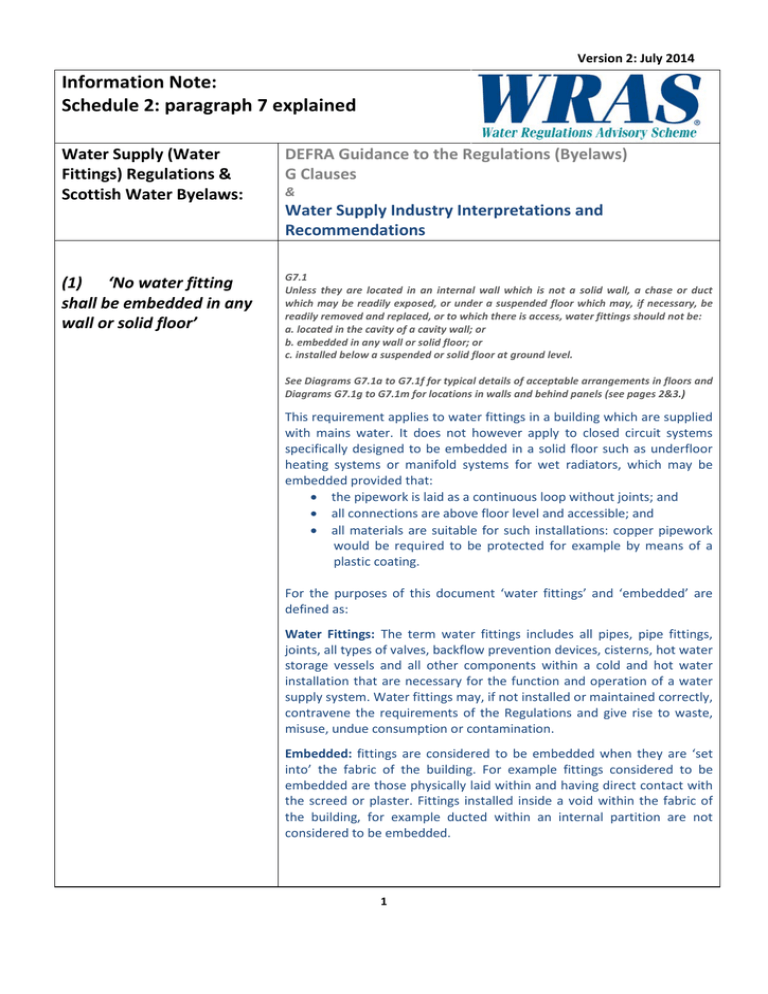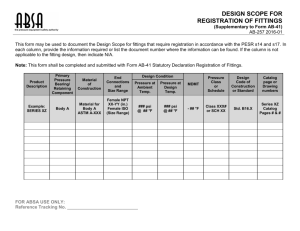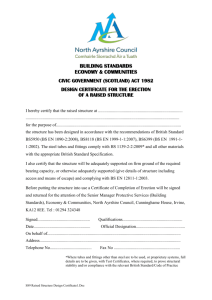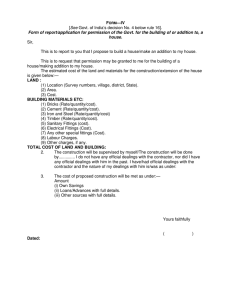Schedule 2: paragraph 7 explained
advertisement

Version 2: July 2014 Information Note: Schedule 2: paragraph 7 explained Water Supply (Water Fittings) Regulations & Scottish Water Byelaws: DEFRA Guidance to the Regulations (Byelaws) G Clauses (1) ‘No water fitting shall be embedded in any wall or solid floor’ G7.1 Unless they are located in an internal wall which is not a solid wall, a chase or duct which may be readily exposed, or under a suspended floor which may, if necessary, be readily removed and replaced, or to which there is access, water fittings should not be: a. located in the cavity of a cavity wall; or b. embedded in any wall or solid floor; or c. installed below a suspended or solid floor at ground level. & Water Supply Industry Interpretations and Recommendations See Diagrams G7.1a to G7.1f for typical details of acceptable arrangements in floors and Diagrams G7.1g to G7.1m for locations in walls and behind panels (see pages 2&3.) This requirement applies to water fittings in a building which are supplied with mains water. It does not however apply to closed circuit systems specifically designed to be embedded in a solid floor such as underfloor heating systems or manifold systems for wet radiators, which may be embedded provided that: • the pipework is laid as a continuous loop without joints; and • all connections are above floor level and accessible; and • all materials are suitable for such installations: copper pipework would be required to be protected for example by means of a plastic coating. For the purposes of this document ‘water fittings’ and ‘embedded’ are defined as: Water Fittings: The term water fittings includes all pipes, pipe fittings, joints, all types of valves, backflow prevention devices, cisterns, hot water storage vessels and all other components within a cold and hot water installation that are necessary for the function and operation of a water supply system. Water fittings may, if not installed or maintained correctly, contravene the requirements of the Regulations and give rise to waste, misuse, undue consumption or contamination. Embedded: fittings are considered to be embedded when they are ‘set into’ the fabric of the building. For example fittings considered to be embedded are those physically laid within and having direct contact with the screed or plaster. Fittings installed inside a void within the fabric of the building, for example ducted within an internal partition are not considered to be embedded. 1 2 3 (2) ‘No fitting which is designed to be operated or maintained, whether manually or electronically, or which consists of a joint, shall be a concealed water fitting.’ (3) ‘Any concealed water fitting or mechanical backflow prevention device, not being a terminal fitting, shall be made of gunmetal, or another material resistant to dezincification.’ G7.3 A concealed pipe may be installed in a pipe sleeve or duct located under or within a solid floor provided that the pipe can be readily removed and replaced. G7.10 Water fittings installed underground should not be jointed or connected to any other water fitting by adhesives. This requirement does not apply to pipe or pipework connected by means of an in line soldered, fusion welded or manipulative joint. In line joints made using compression, push-fit, press-fit, solvent and flanged joints on concealed pipework is not permitted. G7.4 Water fittings are to be resistant to corrosion and, where specified, to dezincification. G7.5 All concealed water fittings, except terminal fittings, (including those buried underground), together with backflow prevention devices, are required to be manufactured of gunmetal or other dezincification resistant materials. G7.6 Dezincification resistant fittings should be of DRA quality, the depth of dezincification being not less than 200 microns in any direction. Each fitting should be marked with the symbol CR or DRA and should be tested in accordance with ISO 6509. G7.9 Water fittings laid underground should be resistant to dezincification and be installed to accommodate any movement. This requirement relates to the need to manufacturer fittings from materials which are suitable for the circumstances in which they will be used, clarifying that backflow prevention devices and fittings installed in a duct or chase should be manufactured from suitable corrosion resistant materials. (4) Any water fitting laid below ground level shall have a depth of cover sufficient to prevent water freezing in the fitting. G7.7 Wherever practicable and except for pipes laid under a building, the vertical distance between the top of every water pipe installed below ground and the finished ground level should be: a. b. not less than 750mm; and not more than 1,350mm G7.8 Where compliance with the minimum cover of 750mm is impracticable, and with the written approval of the Water Undertaker, the water fittings should be installed as deep as is practicable below the finished ground level and be adequately protected against damage from freezing and from any other cause. 4 (5) In this paragraph ‘concealed water fitting’ means a water fitting which (a) is installed below ground; This requirement relates to installations in the ground as opposed to installation below ground level, for example in a basement. Fittings buried in the ground are considered to be concealed Fittings installed below ground level but not buried in the ground, including those installed in a chamber, are not considered to be concealed. (b) passes through or under any wall, footing or foundation; G 7.2 Pipes entering buildings at the approved depth should be passed through a duct and the ends of the duct sealed as shown in Diagrams G7.2a, G7.2b and G7.2c to prevent the ingress of gas or vermin into the building. G7.2a G7.2b G7.2c Other acceptable methods of passing through or under walls, footings and foundations are:5 To comply with this requirement both ends of the duct should be sealed. It is also recommended that the methods of ducting described in BS EN 806-4 clause 4.7.3.2 are followed. (c) is enclosed in any chase or duct; Whilst the chase or duct may be embedded the fittings inside would be regarded as being concealed providing that they are not physically attached and so can be removed. A chimney stack is not considered to be an acceptable duct and passing pipe through or up a chimney is not permitted. For the purposes of this document a ‘duct’ or ‘chase’ is defined as: Duct/chase: covered channel which may where appropriate contain insulation but no other materials such as backfill, plaster, screed or cement. Wrapping in insulation alone is not recognized as an acceptable method of ducting. Advice on acceptable methods of ducting is provided in clause 4.7.3.2 of BS EN 806 – 4: 2010. (d) is in any other position which is inaccessible or renders access difficult. The presence of the following surface finishes, appliances and structural fixtures are not considered to be obstacles which make an installation inaccessible or renders access difficult:• Ceramic, stone quarry tiles • Floor and wall tiles (all materials) • Laminate and other wood finishes • Carpet and carpet tiles • Vinyl • Ceiling tiles • White goods • Screed • Bath panels • Bathroom modular systems • Removable panels • Chip board flooring • Raised modular flooring • Bespoke access hatches [Please note that this is a representative not exhaustive or definitive list] 6 The following are however considered as making an installation inaccessible:• The need to remove walls or other structural supports • Fittings installed behind or obscured by immovable objects such as large storage cisterns, fixed appliances, boilers, building extension (including garages, areas of hard standing) over pipe work (unless reasonable access is given such as the pipe is ducted) • The need for complete disconnection of both clean and waste water connections When designing a plumbing system the accessibility of water fittings should be considered. It is recommended that the advice given in clause 4.3.38 of BS 8558: 2011 be followed. 7




